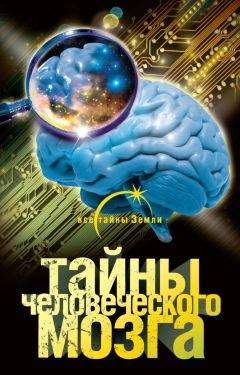Рик Хансон - Мозг и счастье. Загадки современной нейропсихологии
Puri, B. K. 2006. High-resolution magnetic resonance imaging sincinterpolation-based subvoxel registration and semi-automatedquantitative lateral ventricular morphology employing thresholdcomputation and binary image creation in the study of fattyacid interventions in schizophrenia, depression, chronic fatigue syndrome and Huntington’s disease. International Review of Psychiatry 18:149–154.
Quirk, G. J., J. C. Repa and J. E. LeDoux. 1995. Fear conditionin genhances short-latency auditory responses of lateral amygdalaneurons: Parallel recordings in the freely behaving rat. Neuron 15:1029–1039.
Rabinovich, M., R. Huerta and G. Laurent. 2008. Transient dynamics for neural processing. Science 321:48–50.
Raichle, M. 2006. The brain’s dark energy. Science 314:1249–1250.
Raichle, M. and D. Gusnard. 2002. Appraising the brain’s energy-budget. Proceedings of the National Academy of Sciences 99:10237–10239.
Raichle, M. E., A. M. MacLeod, A. Z. Snyder, W. J. Powers, D. A. Gusnard and G. L. Shumlan. 2001. A default mode of brainfunction. Proceedings of the National Academy of Sciences 98:676–682.
Rasia-Filho, A., R. Londero and M. Achaval. 2000. Functional activitiesof the amygdala: An overview. Journal of Psychiatry and Neuroscience 25:14–23.
Rilling, J., D. Gutman, T. Zeh, G. Pagnoni, G. Berns and C. Kilts. 2002. A neural basis for social cooperation. Neuron 35:395–405.
Robinson, P. 2007. How to fill a synapse. Science 316:551–553.
Rosenberg, M. 2008 Second Edition. Nonviolent Communication: A Language of Life . Chicago: Puddledancer Press.
Sapolsky, R. M. 1998. Why Zebras Don’t Get Ulcers . New York: W. H. Freeman Co.
Schechner, S. 2008. Keeping love alive. Wall Street Journal , February 8, W1.
Schore, A. 2003. Affect Regulation and the Repair of the Self. New-York: W. W. Norton.
Seligman, M. 2006. Learned Optimism: How to Change Your Mind and Your Life . New York: Vintage/Random House.
Semaw, S., S. Renne, J. W. K. Harris, C. S. Feibel, R. L. Bernor,
N. Fesseha and K. Mowbray. 1997. 2.5-million-year-old stone tools from Gona, Ethiopia. Nature 385:333–336.
Shantideva. 1997. The Way of the Bodhisattva: A Translation of the-Bodhicharyavatara . Boston: Shambhala.
Shutt, K., A. MacLarnon, M. Heistermann and S. Semple. 2007.
Grooming in Barbary macaques: Better to give than to receive?
Biology Letters 3:231–233.
Siegel, D. J. 2001. The Developing Mind . New York: Guilford Press.
Silk, J. B. 2007. Social components of fitness in primate groups. Science 317:1347–1351.
Simpson, S. W., J. Quade, N. E. Levin, R. Butler, G. Dupont-Nivet,
M. Everett and S. Semaw. 2008. A female Homo erectus pelvis from Gona, Ethiopia. Science 322:1089–1092.
Singer, T. 2006. The neuronal basis and ontogeny of empathy and mind reading. Neuroscience and Biobehavioral Reviews 30:855–863.
Singer, T., B. Seymour, J. O’Doherty, H. Kaube, R. J. Dolan and
C. D. Frith. 2004. Empathy for pain involves the affective but not sensory components of pain. Science 303:1157–1162.
Singer, T., B. Seymour, J. O’Doherty, K. Stephan, R. Dolan and
C. Frith. 2006. Empathic neural responses are modulated by the perceived fairness of others. Nature 439:466–469.
Singh, M. 2005. Essential fatty acids, DHA and human brain. Indian Journal of Pediatrics 72:239–242.
Spagnoli, A., U. Lucca, G. Menasce, L. Bandera, G. Cizza, G. Forloni, M. Tettamanti, L. Frattura, P. Tiraboschi, M. Comelli, U. Senin, A. Longo, A. Petrini, G. Brambilla, A. Belloni, C. Negri,
F. Cavazzuti, A. Salsi, P. Calogero, E. Parma, M. Stramba-Badiale, S. Vitali, G. Andreoni, M. R. Inzoli, G. Santus, R. Caregnato, M. Peruzza, M. Favaretto, C. Bozeglav, M. Alberoni, D. de Leo, L. Serraiotto, A. Baiocchi, S. Scoccia, P. Culotta and
D. Ieracitano. 1991. Long-term acetyl-L-carnitine treatment in Alzheimer’sdisease. Neurology 41:1726.
Spear, L. P., 2000. The adolescent brain and age-related behavioral manifestations. Neuroscience Biobehavior Review 24:417–463.
Stern, D. 2000. The Interpersonal World of the Infant. New York: Basic Books.
Su, K., S. Huang, C. Chiub and W. Shenc. 2003. Omega-3 fatty acids in major depressive disorder: A preliminary double-blind, placebo-controlled trial. European Neuropsychopharmacology 13:267–271.
Sumedho, A. 2006. Trust in awareness. Talk given at Chithurst Monastery, Chithurst, UK, February 25.
Sun, Q. Q., S. S. Xu, J. L. Pan, H. M. Guo and W. Q. Cao. 1999. Huperzine-A capsules enhance memory and learning performancein 34 pairs of matched adolescent students. Zhongguoyao li xue bao [ Acta Pharmacologica Sinica ] 20:601–603.
Takahashi, H., M. Kato, M. Matsuura, D. Mobbs, T. Suhara and Y. Okubo. 2009. When your gain is my pain and your pain ismy gain: Neural correlates of envy and schadenfreude. Science 323:937–939.
Tanaka, J., Y. Horiike, M. Matsuzaki, T. Miyazka, G. Ellis-David and H. Kasai. 2008. Protein synthesis and neurotrophin-dependent structural plasticity of single dendritic spines. Science 319:1683–1687.
Tang, Y., Y. Ma, J. Wang, Y. Fan, S. Feg, Q. Lu, Q. Yu, D. Sui,
M. Rothbart, M. Fan and M. Posner. 2007. Short-term meditation training improves attention and self-regulation. Proceedings of the National Academy of Sciences 104:17152–17156.
Taylor, S. E., L. C. Klein, B. P. Lewis, T. L. Gruenewald, R. A. R. Gurung and J. A. Updegraff. 2000. Biobehavioral responsesto stress in females: Tend-and-befriend, not fight-or-flight. Psychological Review 107:411–429.
Thera, N. 1993. The four sublime states: Contemplations on love, compassion, sympathetic joy and equanimity. Retrieved fromhttp://www.accesstoinsight.org/lib/authors/nyanaponika/wheel006.html on April 3, 2009.
Thompson, E. 2007. Mind in Life: Biology, Phenomenology and the Sciences of Mind . Cambridge, MA: Harvard University Press.
Thompson, E. and F. J. Varela. 2001. Radical embodiment: Neural dynamics and consciousness. Trends in Cognitive Sciences 5:418–425.
Tucker, D. M., D. Derryberry and P. Luu. 2000. Anatomy and physiology of human emotion: Vertical integration of brain stem, limbic and cortical systems. In Handbook of the Neuropsychology of Emotion , edited by J. Borod. London: Oxford University Press.
Vaish, A., T. Grossmann and A. Woodward. 2008. Not all emotion sare created equal: The negativity bias in social-emotional development. Psychological Bulletin 134:383–403.
Vaitl, D., J. Gruzelier, G. Jamieson, D. Lehmann, U. Ott, G. Sammer,
U. Strehl, N. Birbaumer, B. Kotchoubey, A. Kubler, W. Miltner,
P. Putz, I. Strauch, J. Wackermann and T. Weiss. 2005. Psychobiology of altered states of consciousness. Psychological Bulletin 133:149–182.
Vogiatzoglou, A., H. Refsum, C. Johnston, S. M. Smith, K. M. Bradley, C. de Jager, M. M. Budge and A. D. Smith, 2008. Vitamin B12 status and rate of brain volume loss in community-dwellingelderly. Neurology 71:826–832.
Walsh, R. and S. L. Shapiro. 2006. The meeting of meditative discipline sand Western psychology: A mutually enriching dialogue. American Psychologist 61:227–239.
Wilson, E. O. 1999. Consilience: The Unity of Knowledge . London: Random House/Vintage Books.
Wolf, J. L. 1995. Bowel function. In Primary Care of Women , edited by K. J. Carlson and S. A. Eisenstat. St. Louis, MO: Mosby-Year Book, Inc.
Wu, W., A. M. Brickman, J. Luchsinger, P. Ferrazzano, P. Pichiule, M. Yoshita, T. Brown, C. DeCarli, C. A. Barnes, R. Mayeux,
S. Vannucci and S. A. Small. 2008. The brain in the age of old: The hippocampal formation is targeted differentially by diseases of late life. Annals of Neurology 64:698–706.
Yamasaki, H., K. La Bar and G. McCarthy. 2002. Dissociable prefrontal brain systems for attention and emotion. Proceedings of the National Academy of Sciences 99:11447–11451.
Yang, E., D. Zald and R. Blake. 2007. Fearful expressions gain preferential access to awareness during continuous flash suppression. Emotion 7:882–886.
Young, L. and Z. Wang. 2004. The neurobiology of pair bonding. Nature Neuroscience 7:1048–1054.
Zelazo, P. D., H. H. Gao and R. Todd. 2003. The development of consciousness. In The Cambridge Handbook of Consciousness , edited by P. D. Zelazo, M. Moscovitch and E. Thompson. New York: Cambridge University Press.
Алфавитный указатель
А
Аллергия 285
Алчность 30, 73, 127
Ацетилхолин 57, 291
Б
Бдительность 62, 205, 229
Безмятежность 152, 209,
261 Благодать 252
Блаженство (блаженное чувство) 246
В
Вазопрессин 58, 163
Вариабельность сердечного ритма (ВСР) 109
Вегетативная нервная система 83, 104, 125
Витамин B 6 289
Витамин E (см. Токоферолы ) 287
Внимания индивидуальные особенности; 225
направленность; 239 удержание 239
Внимания сосредоточение на дыхании; 114
на своем теле 108
Внутренний словесный поток (внутренняя речь, рассуждение, комментарий; см. еще Планирование ) 109
Вожделение (желание обладать чем-то, см. еще: Алчность ) 41, 141
Г
Гамма-аминомасляная кислота (ГАМК) 57
Гамма-волны (мозга) 28, 248
Гештальт (неделимый единый образ)231
Гиппокамп 20, 55, 56, 75, 78, 285
Глубокий выдох 107
Глютамат 57
Гомоцистеин 286
Д
Диафрагмальное дыхание 106
Добродетель 30, 68, 168, 184
Добродетельная твердость 174
Дофамин 36, 57, 93, 128, 222, 290
Дхъяна (состояние высшей сосредоточенности в буддизме)238
И
Исконное переживание своего существования (бытия) 246
Истинное «я» (истинная сущность) 33, 86
К
Концентрация, фокус (см. Сосредоточенность ) 33, 108, 200, 239
Кортизол 58, 75, 112
Л
Лимбическая система 26, 52, 77
Личностно значимый, значимый (об информации, событии) 264
Личность 47, 118, 174, 213,263
М
Медитация 14, 28, 31, 111, 200, 238, 250
Метилирование 286
Миелинизация 161
Миндалевидное тело 55, 74,
128, 132 Мозолистое тело 77
Мудрость 30, 236
Н
Настороженность 62, 92, 116, 229
Невежество 64, 120, 169
Невозмутимость 141
Независимая добродетель 184
Нейромодуляторы 57, 77, 128
Нейропептиды 57
Нейропластичность 97
Нейропсихология 28
Нейротрансмиттеры (нейромедиаторы) 21,36, 48, 51, 57, 197, 288
Норадреналин 57, 75, 82, 136, 290
О
Окситоцин 58, 79, 94, 163
Оперативная память (рабочая память) 131, 182, 222
Опиоиды 57
Ось гипоталамус – гипофиз– надпочечники (ГГН) 74, 79, 88, 166
Отождествление (с кем-то, чем-то) 212, 269
П
Парасимпатическая нервная система 31, 83, 104
Паттерн (нейронный) 59, 63, 95, 233, 259
Переживание (чувство, ощущение; см. еще Состояние ) внутреннего единства; 253
восхищения; 253
радости; 253
расширения сознания; 248
связи со всем миром (см. еще Сопричастие ). 279
Полиненасыщенные жирные кислоты (ПНЖК) группы омега-3 287
Последовательной релаксации метод 106
Потребность в стимулировании (новых стимулах) 221
Префронтальная (или лобная) кора (кора лобных долей мозга) 31, 52, 77, 128
Преходящая суть бытия 196
Прикосновение к губам 107
Принцип «здесь и сейчас» 249
Пробуждение (см. еще Прозрение, Просветление ) 9
Прозрение (озарение) 116, 184
Просветление 246
Прямая спина 113
Пустое пространство 144
Р
Равновесие внутреннее 108
Релаксация (расслабление) 105
Речевые центры (в мозге) 137, 230, 231
С
Самость 260, 267
Сенсорная депривация 221
Серотонин 48, 57, 289
Симпатическая нервная система 75, 84, 146
Синапс 21, 32, 49, 95
Соблюдение границ 187
Собственный кодекс взаимоотношений 188
Созерцание 24, 245
Сознания единство; 231
объекты (содержание); 232
поле; 146, 232
полнота; 113
пространство; 149
свет (сияние); 172
ясность 204, 229
Сопереживание (сострадание, сочувствие; см. еще Эмпатия ) 31, 68, 155, 160
Сопричастность 179, 183, 256
Сосредоточенность (см. еще Внимание)30, 237
Состояние (см. также Переживание )




